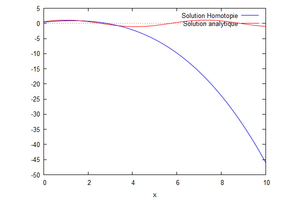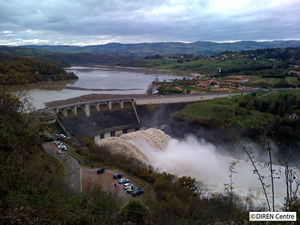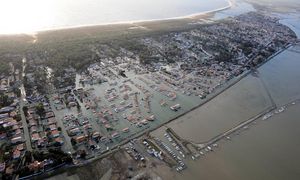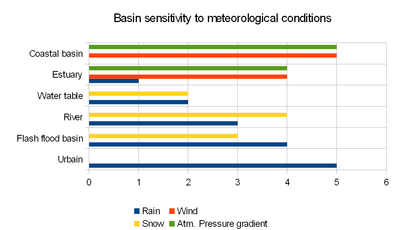Typologie des bassins versants/en
 Language: Language: |
Français • English |
Sommaire |
Context
The analysis of the historical flood events that occur in the different countries all over the planet shows very different hydrological behavior of the watersheds due to heavy rain combined with storms. These strong events produce very often many losses of human lives and disasters on economic goods. This conducts to try to identify the main parameters which characterize these events. The first solicitation is the rain with its intensity, its spatial distribution and its duration. But with the same rain distribution, we observe different responses of the watersheds in terms of flood characteristics, mainly depending on the catchment : type of soil, occupation, drainage network... so, rain is not the only parameter which have a main influence on flood. Flood is also depending on the physical characteristics of the hydrological basin. The photographs thereafter shows different types of disasters on basins. We use to identify 6 different types of basin, that we can classify, depending on their surface and their hydrological time response :
Urban basin
It presents the quicker response to rain which falls on impermeable surfaces, without infiltration. The time response which represents the concentration of water, running in the street with high speed and height, transport mud, vehicles and debris in a torrential regime, entering houses and destroying belongings. The rapidity of the process makes it dependent only on meteorological conditions, specially on characteristics of the rain : intensity, distribution and duration. People security must be prepared in advance by civil defense services in a prevention process through risk management plans. The water concentration in streets and open area could be estimated by means of hydrological models and related to rain intensity. In France, the heavy rains the 19 September 2002 in Marseilles produces a lot of damages. The well managed crises by the fire brigades allowed them to save lives.
For this type of event, the technical services in charge of flood prevention use statistical analysis of historical events, classifying each of them in a diagram (instantaneous rain intensity vs water accumulation) and using this diagram to deploy civil security brigades in the streets to avoid behaviors at risk.
Hydrological Behaviour
- Mainly depends on meteorological conditions : rain intensity and duration
- Very quick process : a few hours
- Main process : run-off on impermeable surfaces, without infiltration
- Water concentration in streets produces high water levels and high velocities
- Devices : meteorolocal radar if available
- Forecast = meteorological forecast
- Crisis management : fire brigades with the help of town employees to inform people, close roads, install pumps, take care of children in schools and of aged people
Exemple : Nîmes 1988, Marseilles 2002
Risk management
Prevention
- Improve knowledge of hazards : set-up dense measurement devices network, give access to meteorological radar (if avalaible)
- Reduce the vulnerability to flooding of the population, goods and activities : no construction in flooding areas, public information
- Involves city community, NGOs, general public (resilience)
Crisis management
- Flood awareness, flood forecasting, vigilance map, public information, application of the crisis management plan
- Involves fire brigades, city communities and general public
After crisis
- quick return to « normal » situation : resilience, quick insurance cost bearing
- Involves fire brigades, city communities and general public
- Start lessons learned
Flash flood basin
This type of basins is mostly located upstream, in mountain reliefs. To produce flood, rain precipitations must be heavy, due to the stagnation of huge heavy clouds above these basins. This produces high concentration of water with high run-off velocities and water depths. The nature of soils, mainly their capabilities to infiltrate water is only sensitive at the very beginning of the event. When the soils are saturated, all the fallen water runs-off and concentrates. The hydrological response of the basin is very quick – some hours – and is accompanied by propagation of mixed water, mud and debris high waves in a very turbulent regime. Population located in the valleys have often little possibilities to escape if there were not evacuated before the incoming wave. This events, like in Sommières in 2005 in France, provoke the loss of lives and destruction of houses, bridges and infrastructures. The prevention process in these basins must take into account this dynamic and risk management plans must be published for the local representatives and the civil defense services to allow them to react very quickly to evacuate people as early as possible.
The hydrometric gauging station network on this basin must have a high density, to record flood propagation.
The simulation models which can be used here are of hydrological type. In France, the tank model type, which is a conceptual model based on the separation of the rain in infiltration and in run-off components is widely spread on this type of basin. Run-off is propagated with a pre determined shape hydrogramme. New models appears : they couple kinematic models in the watershed for water run-off, infiltration and concentration with hydraulic one for propagation in the river bed.
Hydrological Behaviour
- Concerns upper basins, in mountain reliefs
- Maily depends on meteorological conditions : rain precipitation can be heavy (high intensity) and long, due to cloud stagnation on relief (650 mm in 24h)
- Impact of the nature of soil (infiltration at the very beginning)
- Very quick hydrological basin response : (flash floods) some hours with a large inundation area and high water levels as well as high velocities, high concentration of sand deposition, high water wave propagation downstream
- Effects : many deaths of people and animals, houses and infrastructure destruction
- Exemple : Sommières 2005
Risk management
Prevention
- Improve knowledge of hazards : set up dense gauging stations network, modeling hydrological flood forecasting tools (mainly tank models, 1D hydraulic + Kinetic))
- Reduce the vulnerability to flooding of the population, goods and activities : no construction in flooding areas, public information
- Involves government services (national and flood forecasting services), local communities, NGOs, general public (resilience)
Crisis management
- flood awareness, flood forecasting, vigilance map, public information, application of the crisis management plan
- Involves government services (national and flood forecasting services), fire brigades, local communities and general public
After crisis
- quick return to « normal » situation : resilience, quick insurance cost bearing
- Involves fire brigades, local communities and general public
- Start lessons learned
River basin
River basins can be of different sizes, composed of hydrological basins (flash flood or not basins) connected to the river stretches as well as tributaries. In the main course, the propagation of flow is the principal process, but when flood occurs, it can provoke overflooding of flood plain directly, but also by overtopping levees going to destruction of part of them. The flow in the plain can have slow or high velocities, low or high water level. The duration of such inundation can vary from days to weeks, mainly depending on the physical characteristics of the flood plain, the nature of soils and the presence of structure works. The rapidity of flood propagation is not so high compared with those of flash flood basins and these rivers stretches are sufficiently far from the upper basin to allow civil security services to prevent population of the danger. The overflooding can be disastrous in case of levee breaking. An example of this type of flood in France is during November 1999 in Cuxac-d'Aude where 21 people died and 500 houses were devastated. The hydrometric stations must be placed on specific locations to allow the evaluation of the flood propagation and the possible structures overfloodings. These measurement devices are also used to give boundary conditions to simulation models. The simulation of these hydraulic process is possible, using Saint-Venant type models in 1D if the flow keeps a unique direction. When the topography, the presence of works or singularities make the use of 1D models inappropriate, 2D models can drastically improve the accuracy of the results.
Hydrological behaviour
- Concerns intermediaite basins, in plains with mild slopes
- Flooding can result from different causes :
- Meteorological conditions : heavy rain precipitation on upper and/or side basins
- Flood propagation from upstream
- Impact of the nature of soil : in general low
- Characteristics :
- High rapid water level rise (high water wave propagation downstream)
- Propagation from upstream can take some days with large inundation areas, high water levels as well as high velocities, sediment, transport and bed evolution (sandy bottoms)
- Effects : people have time to take measures (resilience) to leave flooded areas. Not so many deaths compared with flash flood basins but destruction of houses and infrastructure.
Exemple : Paris (1910)
Risk management
Prevention
- Improve knowledge of hazards : set up gauging stations network, modeling hydraulic flood forecasting tools (1D or 2D hydraulic + hydrological models for tributaries)
- Reduce the vulnerability to flooding of the population, goods and activities : no construction in flooding areas, public information
- Involves government services (national and flood forecasting services), local communities, NGOs, general public (resilience)
Crisis management
- flood awareness, flood forecasting, vigilance map, public information, application of the crisis management plan
- Involves government services (national and flood forecasting services), fire brigades, local communities and general public
After crisis
- quick return to « normal » situation : resilience, quick insurance cost bearing
- Involves fire brigades, local communities and general public
- Start lessons learned
Estuaries
These basins constitute the connection between the river and the sea. They can be small like in French Brittany, with high longitudinal slopes coming from mounts. In this situation their behaviors are very similar than those of flash flood basins. But estuaries can also be very wide : more than several kilometers, like Gironde Estuary on the west Atlantic Coast of France. But all of them are subjected to downstream influence of the sea, which can produce water elevation due to tide, storm surges, wind and wave actions. The upstream condition is given by the river which can propagate flood. The combination of all theses processes can produce high water levels and consequently inundations along the estuary banks. This was the case with the storm occurred on the Gironde Estuary in France the 27th of December 1999, where some people died and where there was a lot of goods destruction. To ensure the survey of estuaries, it is important to install some buoys in the vicinity of the mouth, water levels gauges, wind intensity gauges along the stretch. To understand and reproduce the hydraulic behavior of estuaries and their response under storm conditions it is necessary to record meteorological storm conditions and get the results of meteorological models as well as sea evolution models. The dangerous nature of the meteorological events like storms with storm surges, flood propagation from upstream of rivers can produce a lot of damages and unfortunately losses of lives. The time of occurring such storms and the effects on estuaries can be very short : some hours only. The typology of simulations tools is the same than for rivers : 1D or 2D Saint-Venant system, but completed by wave modeling and meteorology parameters.
Hydraulic behaviour
- Concerns downstream basins, in contact with river basin and sea conditions
- Flooding can result from combined causes :
- Meteorological storm : heavy rain precipitation on the basin submitted to strong wind which rises coastal water level
- Flood propagation with high discharge coming from upstream
- Storm surges coming from sea conditions and propagate upstream (wave increase for hypersynchroneous estuaries)
- High tide level and wave set-up which increase mean water level
- Tidal bore (tsunamies)
- Characteristics :
- High rapid water level rise : conjonction of upsteam discharge and storm surge level rise propagation
- Large inundation areas, high water levels as well as high velocities, sediment transport and bed evolution (sandy bottoms)
- Development of this phenomenon is very quick (somes hours)
- Effects : people have time to take measures (resilience) to leave flooded areas. Not so many deaths but destruction of houses and infrastructures.
- Exemple : Storm Xynthia (2010)
Risk management
Prevention
- Improve knowledge of hazards : set up gauging stations network all along the estuary, modeling hydraulic flood forecasting tools (1D or 2D hydraulic)
- Reduce the vulnerability to flooding of the population, goods and activities : no construction in flooding areas, public information
- Involves government services (national and flood forecasting services), local communities, NGOs, general public (resilience)
Crisis management
- flood awareness, flood forecasting, vigilance map, public information, application of the crisis management plan
- Involves government services (national and flood forecasting services), fire brigades, local communities and general public
After crisis
- quick return to « normal » situation : resilience, quick insurance cost bearing
- Involves fire brigades, local communities and general public
- Start lessons learned
Water table basin
This type of basin offers a behavior characterized by a long inertia, driven by the water table fluctuations. This type of basin is most of the time a flat plain. The water level rises during some days. As an example, on the Somme River in April – May 2001 in France, the intensity of the phenomenon was huge : 3500 cellars were inundated and 1100 people were evacuated. The dynamic of the flow is complex and combine two times steps. : the vertical dynamic of the water table is very slow governed by the water table. When water rises the surface of the plain, it begins to flow downstream in the direction of the steepest slope, with higher velocities.
The devices to measure these two phenomenon are mainly a piezometer network for the fluctuation of the water table and a limnimeter network for the evolution of the water depth in the river.
To simulate these combined processes, two types of models should be used : one is to reproduce the long time vertical water table evolution : the most adapted model is a tank model concept. The surface flow process could be simulated using a 1D or 2D hydraulic model, taking into account the incoming water from the water table as an contribution at each point of the inundated mesh.
Hydraulic behaviour
- Concerns intermediate basins, in plains with very mild slopes
- Impact of the nature of soil : important for the close connection between water table and water level in the river
- Flooding can result from different causes :
- Meteorological conditions : heavy rain precipitation on upper and/or side basins
- Water table rise
- Characteristics :
- Very low water level rise due to inertia of the water table. Can reach several meters high
- Propagation downstream
- Inundation can take some weeks to evacuate
- Effects : people have time to take measures (resilience) to leave flooded areas. In general, no death but destruction of houses and infrastructure.
- Exemple : Amiens / Somme river (2001)
Risk management
Prevention
- Improve knowledge of hazards : set up gauging stations network : pizometers, modeling hydrogeologic water table (also tank models) combined with hydraulic propagation tools (1D or 2D hydraulic + hydrological models for tributaries)
- Reduce the vulnerability to flooding of the population, goods and activities : no construction in flooding areas, public information. No protection behind dikes : the water comes from the bottom everywhere.
- Involves government services (national and flood forecasting services), local communities, NGOs, general public (resilience)
Crisis management
- flood awareness, flood forecasting, vigilance map, public information, application of the crisis management plan
- Involves government services (national and flood forecasting services), fire brigades, local communities and general public
After crisis
- quick return to « normal » situation : resilience, quick insurance cost bearing
- Involves fire brigades, local communities and general public
- Start lessons learned
Coastal basins
These basins are most of the time very difficult to define by their limits, whose surface depends on to the territories subject to the action of the sea. They are in their behavior very similar to the side flood plain of rivers. They can be overflooded by sea during storm, being subjected to soil erosion and transportation by currents – sandy or shingle beaches, land slides – or depending on the presence of dikes, levees which are subjected to overtopping and in some cases to dikes decay. The main solicitations are coming from the rise of the water level due to tide, storm surges, wind and waves : the waves having a special nasty effect by their action of hammering on structures. These combined effect are very difficult to be predicted. Different confrontation of expertise are needed from specialists : meteorologists, sea modelers, maritime hydrologists, specialists of structure resistance... These effects can occur very quickly and be dangerous due to the overrun of a threshold corresponding for example of the top level of a levee. In this last case, the flooding is on the order of a few hours and can cause a lot of damages and losses of lives like in France during the Xynthia storm in December 2010, where 59 people died.
The good comprehension of the processes could be improve by installing a survey of the coastline with buoys, water level gauges, wind recorder and most important results of meteorological simulations.
The simulation of this processes can be done by superposition of different kind of tools, fed by meteorological conditions (Wind) : wave propagation, current generation.
Hydraulic behaviour
- Concerns areas situated along the coast, sometimes protected by dikes and submitted to sea conditions
- These basins can be compared to ponds (close basin) where water cannot flow out
- Flooding can result from combined causes :
- Meteorological storm : heavy rain precipitation on the basin, submitted to strong wind
- Incoming discharge from tributaries or run-off inside the basin
- Storm surges coming from sea conditions, combined with wave set-up which increases mean water level and can produce dike failures
- Tidal bore or tsunamies
- Characteristics :
- flash water level rise : conjonction of run-off, incoming tributaries discharges, upsteam discharge and, more awfull, water wave coming from dikes destruction
- Large inundation areas, high water levels
- Development of this phenomenon is very quick (some hours)
- Effects : Deaths and destruction of houses and infrastructures.
- Exemple : Storm Xynthia (2010)
Risk management
Prevention
- Improve knowledge of hazards : modeling sea state conditions combined with incoming upstream discharge (hydraulic flood forecasting tools (2D hydraulic))
- Reduce the vulnerability to flooding of the population, goods and activities : no construction in flooding areas, public information
- Involves government services (national and flood forecasting services), local communities, NGOs, general public (resilience)
Crisis management
- flood awareness, flood forecasting, vigilance map, public information, application of the crisis management plan
- Involves government services (national and flood forecasting services), dikes survey, fire brigades, local communities and general public
After crisis
- quick return to « normal » situation : resilience, quick insurance cost bearing
- Involves fire brigades, local communities and general public
- Start lessons learned
Conclusion
The previous presentation of the hydrological basin typology shows that a flooding event depends on the meteorological conditions but mainly result of the physical characteristics of the basin. The diagram thereafter shows qualitatively (scale from 0 : no dependance to 5 great dependance) the sensibility of the basins to the meteorological parameters : rain, wind, snow and pressure gradients. We can draw some remarks:
- the more the basins are upstream, the more the rain makes the basin react;
- snow, mainly by its water equivalent and its retention effect, can have significant flooding consequences during a snow melt event;
- far downsteam, sea conditions are the main parameters, especialy the storms which can produce huge desasters
Note : d'autres personnes peuvent avoir contribué au contenu de cet article, [Consultez l'historique]. |
 S'abonner à un flux RSS
S'abonner à un flux RSS







